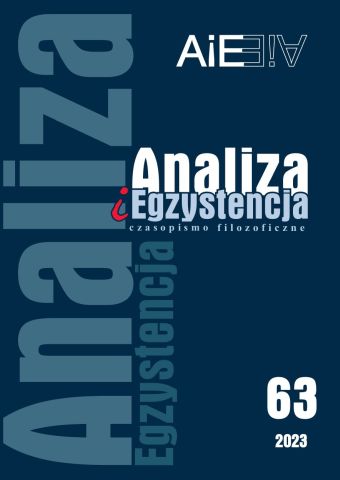
ISSN: 1734-9923
eISSN: 2300-7621
OAI
DOI: 10.18276/aie.2023.63-04





Issue archive /
63 (2023)
Ingarden’s Aesthetic Argument Against Husserl’s Transcendental Idealism Turn
| Authors: |
Hicham
Jakha

John Paul II Catholic University of Lublin |
| Keywords: | idealism–realism phenomenology aesthetics |
| Data publikacji całości: | 2023 |
| Page range: | 20 (89-108) |
Abstract
Husserl’s allegiance to realism came under attack following his Ideas. Ingarden was a fierce critic of his teacher’s turn to transcendental idealism, and provided compelling arguments both for his idealist reading of Husserl and for his rejection of idealism. One of the main arguments Ingarden devised against Husserl’s turn was based on his aesthetics. Against Husserl, Ingarden established literary works and fictional objects as purely intentional objects that are (1) doubly-structured, vis-à-vis their formal ontology, and (2) endowed with spots of indeterminacy. These facts, Ingarden argues, necessitate the transcendence of the purely intentional object. In this paper, I explore his argument, while establishing the ontological foundation on which it rests.
Download file
Article file
Bibliography
| 1. | Ameriks, K. (1977). Husserl’s Realism. The Philosophical Review, 86(4), 498–519. https://doi.org/10.2307/2184565 |
| 2. | Haefliger, G. (1990). Ingarden und Husserls Transzendentaler Idealismus. Husserl Studies, 7(2), 103–121. https://doi.org/10.1007/BF00157156 |
| 3. | Hall, H. (1982). Was Husserl a Realist or an Idealist? In H. L. Dreyfus & H. Hall (Eds.), Husserl, Intentionality and Cognitive Science (pp. 169–190). MIT Press. |
| 4. | Holmes, R. H. (1975). Is Transcendental Phenomenology Committed to Idealism. The Monist, 59(1), 98–114. https://doi.org/10.5840/monist19755912 |
| 5. | Husserl, E. (1979). Aufsätze und Vorträge (1890-1910). Kluwer. |
| 6. | ––––––. (1982). Ideas Pertaining to a Pure Phenomenology and to a Phenomenological Philosophy: Vol. First Book (F. Kersten, Trans.). Nijhoff. |
| 7. | ––––––. (1994). Briefwechsel. Band I. Die Brentanoschule. Kluwer. |
| 8. | Ingarden, R. (1921). Über die Gefahr einer Petitio principii in der Erkenntnistheorie. Jahrbuch Für Philosophie Und Phänomenologische Forschung, 4, 545–568. |
| 9. | ––––––. (1973). The Literary Work of Art (G. G. Grabowicz, Trans.). Northwestern University Press. |
| 10. | ––––––. (1975). On the Motives which Led Husserl to Transcendental Idealism (A. Hannibalsson, Trans.). Martinus Nijhoff. |
| 11. | ––––––. (1976). The Letter to Husserl about the VI [Logical] Investigation and “Idealism.” In A.-T. Tymieniecka (Ed.), Ingardeniana (pp. 419–438). Reidel. |
| 12. | ––––––. (1992). Einführung in die Phänomenologie Edmund Husserls – “Osloer”-Vorlesungen (1967) (G. Haefliger, Ed.; Vol. 4). Max Niemeyer Verlag. |
| 13. | ––––––. (2013). Controversy over the Existence of the World: Vol. I (A. Szylewicz, Trans.). Peter Lang GmbH. |
| 14. | ––––––. (2016). Controversy over the Existence of the World: Vol. II (A. Szylewicz, Trans.). Peter Lang GmbH. |
| 15. | Jansen, J. (2005). On the development of Husserl’s transcendental phenomenology of imagination and its use for interdisciplinary research. Phenomenology and the Cognitive Sciences, 4(2), 121–132. https://doi.org/10.1007/s11097-005-0135-9 |
| 16. | ––––––. (2016). Husserl. In A. Kind (Ed.), The Routledge Handbook of Philosophy of Imagination (pp. 69–81). Routledge. |
| 17. | Küng, G. (1972). The World as Noema and as Referent. Journal of the British Society for Phenomenology, 3(1), 15–26. https://doi.org/10.1080/00071773.1972.11006220 |
| 18. | ––––––. (1973). Husserl on Pictures and Intentional Objects. The Review of Metaphysics, 26(4), 670–680. |
| 19. | ––––––. (1975). Zum Lebenswerk von Roman Ingarden. Ontologie, Erkenntnistheorie und Metaphysik. In H. Kuhn, E. Avé-Lallemant, & R. Gladiator (Eds.), Die Münchener Phänomenologie (pp. 158–173). Nijhoff. |
| 20. | ––––––. (1993). Welterkennen und Textinterpretation Bei Roman Ingarden und Nelson Goodman. Grazer Philosophische Studien, 44(1), 69–90. https://doi.org/10.1163/18756735-90000520 |
| 21. | Makota, J. (1995). Roman Ingarden’s Controversy with Edmund Husserl. In A. Węgrzecki (Ed.), Roman Ingarden a Filozofia Naszego Czasu (pp. 283–295). Polskie Towarzystwo Filozoficzne. |
| 22. | Mitscherling, J. (1997). Roman Ingarden’s Ontology and Aesthetics. University of Ottawa Press. |
| 23. | Sartre, J.-P. (1991). The Psychology of Imagination. Carol Publishing Group. |
| 24. | Sokolowski, R. (1977). On the Motives Which Led Husserl to Transcendental Idealism. The Journal of Philosophy, 74(3), 176–180. https://doi.org/10.2307/2025608 |
| 25. | Thomasson, A. L. (1999). Fiction and Metaphysics. Cambridge University Press. |
| 26. | Tymieniecka, A.-T. (1976). Beyond Ingarden’s Idealism/Realism Controversy with Husserl: The New Contextual Phase of Phenomenology. In A.-T. Tymieniecka (Ed.), Ingardeniana: A Spectrum of Specialised Studies Establishing a Field of Research: Vol. Analecta Husserliana IV (pp. 241–418). Reidel. |
| 27. | Wallner, I. M. (1987). In Defense of Husserl’s Transcendental Idealism: Roman Ingarden’s Critique Re-Examined. Husserl Studies, 4(1), 3–43. https://doi.org/10.1007/BF00375881 |
| 28. | Wolterstorff, N. (1980). Works and Worlds of Art. Clarendon Press |